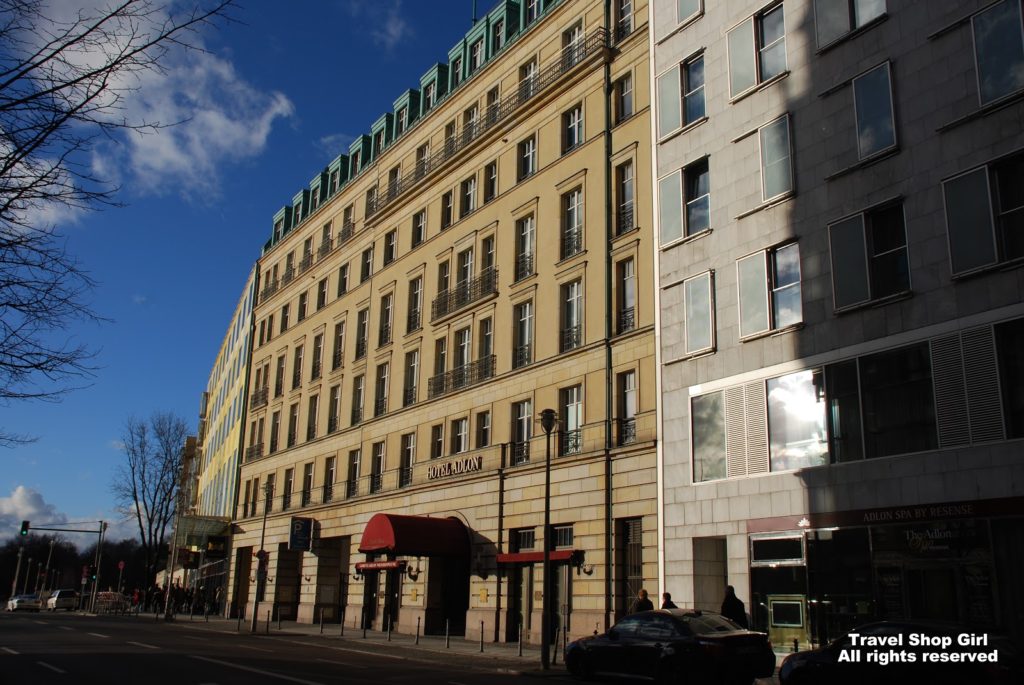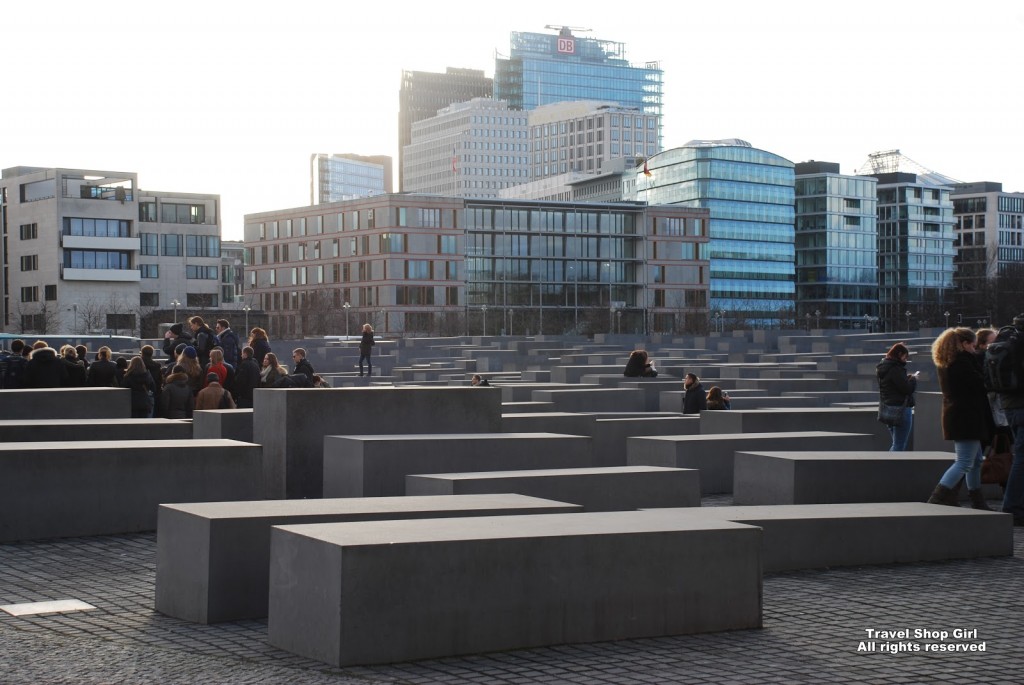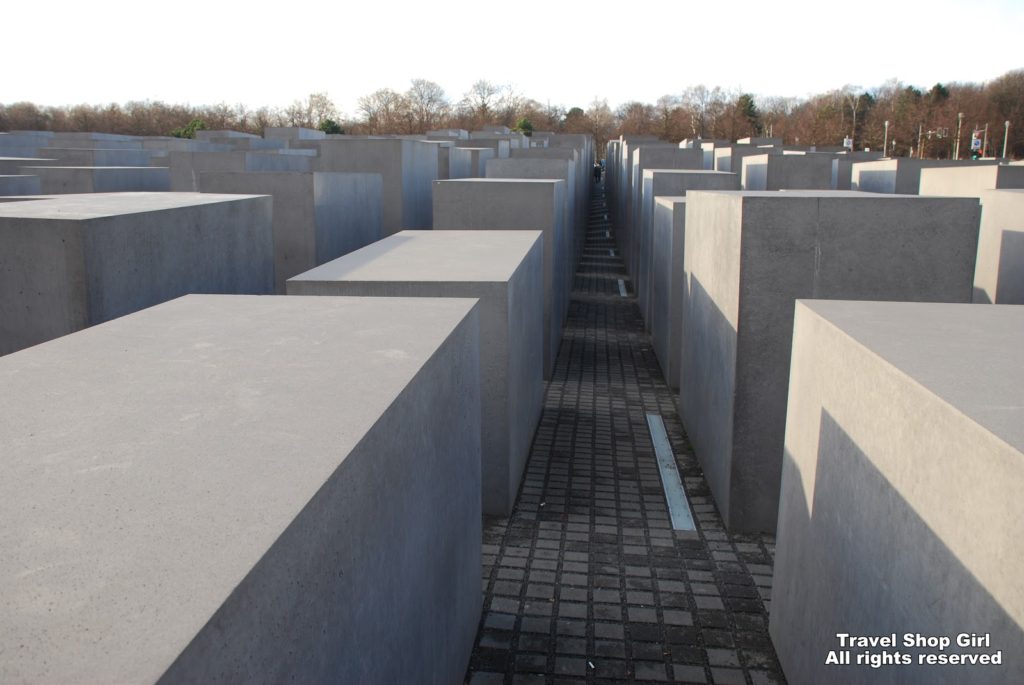
Adjusting to the time difference from Boston to Berlin plus jet lag eventually caught up with us. Somehow, we woke up later than we ever would at home because we were oblivious as to what time it was in Berlin. Regardless of what time it was or how we felt, we finally made it out the door and off on another trip around Berlin. On this day we were going to visit the Holocaust Memorial and Hitler’s Bunker.
After only a few days, we were already getting a feel for the city of Berlin. How was it possible that we weren’t having any problem getting from point A to point B? Again we walked by the Brandenburg Gate, but close to the rear of the Adlon Hotel. From there we walked on toward the Memorial to the Murdered Jews of Europe.
Memorial to the Murdered Jews of Europe

The Memorial to the Murdered Jews of Europe is the German Holocaust Memorial honoring and remembering the up to six million Jewish victims of the Holocaust. Located between the Brandenburg Gate and Potsdamer Platz, the Memorial consists of the Field of Stelae designed by Peter Eisenman and the subterranean Information Centre. The admission is free of charge.

The entrance is down a flight of steps near the admission line forms. Since admittance is controlled, you’ll have a specific time to enter. While there might be a line upon arrival when you go inside the Information Centre, you can roam among the stelae on your own and enter from any one of the four sides.

Created by renowned New York architect Peter Eisenman, the Field of Stelae seems at first nothing more than a sea of grey concrete. Numbering 2,711 stelae in total, they range in height from 0.2 m to 4.7 m (0.65 feet to 15.4 feet), the stelae cover gently and unevenly sloping ground covering 19,000 square meters (just over 2,000 square feet). With the uneven ground, you experience the wave-like form differently throughout.

The height of the stelae change throughout the memorial. But why stelae and why this overall shape for such an important memorial? The architect’s explanation:
The enormity and scale of the horror of the Holocaust is such that any attempt to represent it by traditional means is inevitably inadequate … Our memorial attempts to present a new idea of memory as distinct from nostalgia … We can only know the past today through a manifestation in the present. (Peter Eisenman, 1998)
Inside the Memorial to the Murdered Jews of Europe

Inside the museum the ceiling reflects the raised stelae outside and continues throughout the museum. There are several parts to the museum including the Room of Dimensions, the Room of Families, the Room of Names, and the Room of Sites.

The Starting Hall has six large portraits at one end that represent the six million Jewish victims. Each one represents a specific age and gender group: Men and women, children, adults, and the elderly. As you move through the exhibition inside the Information Centre, which starts with an overview of the National Socialist terror policy between 1933 and 1945, you can’t help but notice how incredibly still it is. Despite the sheer number of people inside, I could hear a pin drop.
Almost immediately upon arrival, I stopped taking pictures. I was completely consumed by the visuals as well as the stories. Following the stories of families through their pictures and sometimes even stories that they told afterwards was difficult to hear, but necessary.
Room of Names
For a poignant reminder of the sheer number of lives lost, enter the Room of Names. Simply put, this is a room where names are read along with information about each and every person who died. Their names are also shone on the walls so between their name being read and lit on the wall, it’s a tribute to each of them. This is regardless of whether they are names people had heard of or not. You can view the Room of Names and other information online here.
The Room of Names contains the dramaturgical climax of the exhibition: the reading of the short biographies of Jews murdered or missing. An attempt is made here to dissolve the incomprehensible abstract number of six million murdered Jews and to release the victims from their anonymity. At the same time, the name, year of birth and death of each person is projected on the four walls.
The National Socialists and their supporters tore apart millions of Jews from their native places, their culture and life world. In most instances, their mortal remains found no proper place of burial, but were buried unmarked or were burned. Only little stands today as testimony to the existence of those murdered. In many cases not even their names are known. Statements by witnesses and the findings of historical research make it possible to memorialize the dead individually. To reconstruct their biographies remains a long and complicated task. The information presented in this room is in keeping with our current level of knowledge. But the search continues. The reading of the names and life stories of all the victims in the form presented here would take approximately six years, seven months and 27 days.
Why You Should Visit the Memorial to the Murdered Jews of Europe
Why go? Even if you think you know about the Holocaust, I’m positive there are things you don’t know that you will learn about here. The haunting images should serve as a reminder to each of us to never let anything like this ever happen again.
Memorial to the Murdered Jews of Europe
Information Center: Cora-Berliner-Straße 1, 10117 Berlin, Germany (Mitte)
Admission: Free
Hitler’s Bunker
Remember I said I was going to visit the Holocaust Memorial and Hitler’s Bunker? Our next stop I went to admittedly, quite reluctantly. My father-in-law asked my husband if he would search out Hitler’s Bunker. Really? The Führerbunker along with a schematic can be found at the corner of In den Ministergärten and Gertrud-Kolmar-Straße, only a short walk from the Memorial to the Murdered Jews of Europe.

All I knew about this site before I came upon it was that Adolf Hitler had spent time inside. I know, not much of a historian with respect to this, but there was something just wrong about being near this place. The bunker, located near the Reich Chancellery, was his air raid shelter and part of his subterranean bunker complex.
Timeline of Events
Here’s an extremely abbreviated timeline of events from 1945:
- January 16, 1945: Hitler moves into the bunker along with some members of his staff as well as Eva Braun.
- April 20, 1945: Hitler makes final trip above ground. That afternoon, Soviet artillery bombards Berlin.
- April 29, 1945: Hitler marries Eva Braun in the map room and shortly thereafter, he dictates his last will and testament.
- April 30, 1945: Hitler and Braun commit suicide.
- April 30/May 1, 1945: Soviets capture the Reichstag.
- May 2, 1945: Soviets storm the Reich Chancellery after the Germans surrender.
Complex Then and Now

The entire complex was comprised of about 30 small rooms over two levels, but all that exists today are some of the corridors, which are now off from the public. Life Magazine released the images that were taken when they entered the bunker only a few years ago, but they are an enlightening look at the conditions of the bunker and the surrounding area.
This area was unmarked and they didn’t even have the schematic up until the 2006 FIFA World Cup. I’m not sure how to feel about it. In one sense, people are curious, like my father-in-law. On the other hand, I can see why the government wouldn’t want people visiting or leaving things there, kind of like a pilgrimage to Hitler’s Bunker. Although it’s a historical site, I wanted out of there as quickly as possible. I just feel bad for the people who live there. Imagine giving directions to someone: Make a left past Hitler’s Bunker… Ugh.
I can’t stand even saying his name. To me it’s like saying “Voldemort.” I never really paid any attention to this part of history (or any other) while I was in school. Ok, I wasn’t the best student in school, especially high school. I definitely came into my own in college and grad school, thank goodness.
Final Thoughts on the Holocaust Memorial and Hitler’s Bunker
I’m so glad I had the chance to visit the Holocaust Memorial and Hitler’s Bunker in Berlin. That’s what I like about my travels now because I find I can fill in those gaps that I otherwise might never have. Travel history = a complete education.
Discover other destinations full of history and culture on the rest of the Travel Shop Girl website. Have you visited Berlin?




@travelshopgirl, thank you for the nice article. With all of the pics. Thanks for your comments, I understand the Memorial a little better now. I understand your feelings about taking pics after getting into the Museum. I had the same effect when I went to Dacau Prison camp, such senseless suffering. HAVE A GREAT DAY!
Signed,
The girl behind the @justcruisesinc tweets in Rochester.
Thanks so much! I had such a lump in my throat while there, but I think it’s necessary to feel uncomfortable to understand the enormity of this atrocity. You have a great day, too!
I’m a history buff, so I find all of this stuff interesting. However, sometimes I get angry with history and then I don’t want to read all the stuff. That happened when I was in Berlin. This part of history is just so upsetting.
I get what you’re saying, but I wanted to push through it and learn as much as I could while I was there. That’s why we also did less historical stuff like eating and drinking (and drinking…).